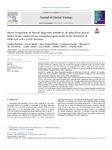2023-06-01Zeitschriftenartikel
Direct comparison of clinical diagnostic sensitivity of saliva from buccal swabs versus combined oro-/nasopharyngeal swabs in the detection of SARS-CoV-2 B.1.1.529 Omicron
Puyskens, Andreas
Michel, Janine
Stoliaroff-Pepin, Anna
Bayram, Fatimanur
Sesver, Akin
Wichmann, Ole
Harder, Thomas
Schaade, Lars
Nitsche, Andreas
Peine, Caroline
Background/Purpose: While current guidelines recommend the use of respiratory tract specimens for the direct
detection of SARS-CoV-2 infection, saliva has recently been suggested as preferred sample type for the sensitive
detection of SARS-CoV-2 B.1.1.529 (Omicron). By comparing saliva collected using buccal swabs and oro-/
nasopharyngeal swabs from patients hospitalized due to COVID-19, we aimed at identifying potential differences
in virus detection sensitivity between these sample types.
Methods: We compare the clinical diagnostic sensitivity of paired buccal swabs and combined oro-/nasopha-
ryngeal swabs from hospitalized, symptomatic COVID-19 patients collected at median six days after symptom
onset by real-time polymerase chain reaction (PCR) and antigen test.
Results: Of the tested SARS-CoV-2 positive sample pairs, 55.8% were identified as SARS-CoV-2 Omicron BA.1 and
44.2% as Omicron BA.2. Real-time PCR from buccal swabs generated significantly higher quantification cycle
(Cq) values compared to those from matched combined oro-/nasopharyngeal swabs and resulted in an increased
number of false-negative PCR results. Reduced diagnostic sensitivity of buccal swabs by real-time PCR was
observed already at day one after symptom onset. Similarly, antigen test detection rates were reduced in buccal
swabs compared to combined oro-/nasopharyngeal swabs.
Conclusion: Our results suggest reduced clinical diagnostic sensitivity of saliva collected using buccal swabs when
compared to combined oro-/nasopharyngeal swabs in the detection of SARS-CoV-2 Omicron in symptomatic
individuals Graphische Zusammenfassung, als Datei angehängt.
Files in this item

